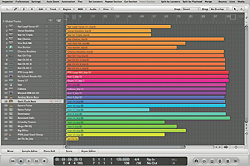
Minimally, a folder that follows the same naming convention as the consolidated audio files should be created to contain all of the associated audio files and metadata (like screen shots, rtf files containing session notes, credits, etc.). This method works fine, but will always require the multitrack to be reconstructed in a DAW for playback.
Alternately, a facility like Pro Tools’ ‘Save Session Copy’ could be used to create a new, independent playback session for only the archival material.
Using this method one would need to be careful to remove any non-archival audio and metadata from the source session before saving the copy.
This approach would facilitate more convenient short-term use of the archive, but doesn’t actually provide any additional content.
What Is A Flat Multitrack?
A Flat Multitrack is a digital audio fileset that completely expresses the EDL information from a multitrack master recording, but also expresses some subset of DAW metadata. What metadata is ‘flattened’ into the archive is up to you, your client, or contractual obligations, but it could include:
—Plug-in processing like amp simulation, ‘printed’ effects from auxiliary channels, or automated processing;
—Automation data, like the fader rides on a lead vocal track;
—Bounced submixes that would otherwise require reconstructing both complex routing and plugin processing.
It is critically important to note that a Flat Multitrack should never be archived instead of a Consolidated Multitrack, but only in addition. The Consolidated Multitrack is the master recording; the Flat Multitrack (when applicable) is an extension of that master.
Once a Consolidated Multitrack has been created, a Flat Multitrack can be created by repeating the process with a few additional steps:
1. From your last active session/project file, ‘Save As’ to create a discrete file from which you will create a Flat Multitrack.
2. Hide or delete all auxiliary signal path and metadata that is not going to be flattened.
3. If additional Takes or Playlists are to be included in the Flat Multitrack, create new tracks to allow all of the source audio to be simultaneously visible/accessible.
4. To flatten real-time processes like automation, time-based effects, or submixing, bounce/re-record the appropriate track outputs to new tracks, and remove the source tracks from the session. Note what metadata has been flattened.
5. Flatten additional metadata by processing audio files with offline versions of real-time plug-ins. Note what metadata has been flattened.
6. Make a global timeline selection, and use the Consolidate or Merge functions to create a single continuous audio file that expresses the EDL information for each track (including whatever metadata has been flattened into them).
7. Carefully, consistently label all of the newly consolidated audio files to reflect enough information that they could completely identify themselves by name, e.g. bassamp_take2_flatcompression_ohbabybaby_jimmysingsalot.wav
Since it would be unlikely that every track within a DAW project would have metadata worth flattening, there will likely be some tracks that remain in their consolidated form. I would caution that it would be both redundant and confusing to include these audio files in a Flat Multitrack archive.
Preferably, an additional folder of flattened audio files can be clearly labeled, and organized with the Consolidated Multitrack data. Future users can then reconstruct the Consolidated archive, and opt-in to any of the available, clearly labeled, flat content.
Contents Versus Carrier
It should be noted that this tutorial only addresses the form of the contents of a multitrack archive. The question of how to effectively store this information is an entirely additional- though related- matter.
Anybody who is serious about the subject should examine the Producer and Engineers Wings’ “Recommendation for Delivery of Recorded Music Projects” (pdf). It contains an example of a widely-adopted approach to redundant archival storage.
Rob Schlette is chief mastering engineer and owner of Anthem Mastering (anthemmastering.com) in St. Louis, MO, which provides trusted specialized mastering services to music clients across North America.
Be sure to visit the Pro Audio Files for more great recording content.
